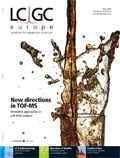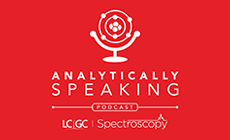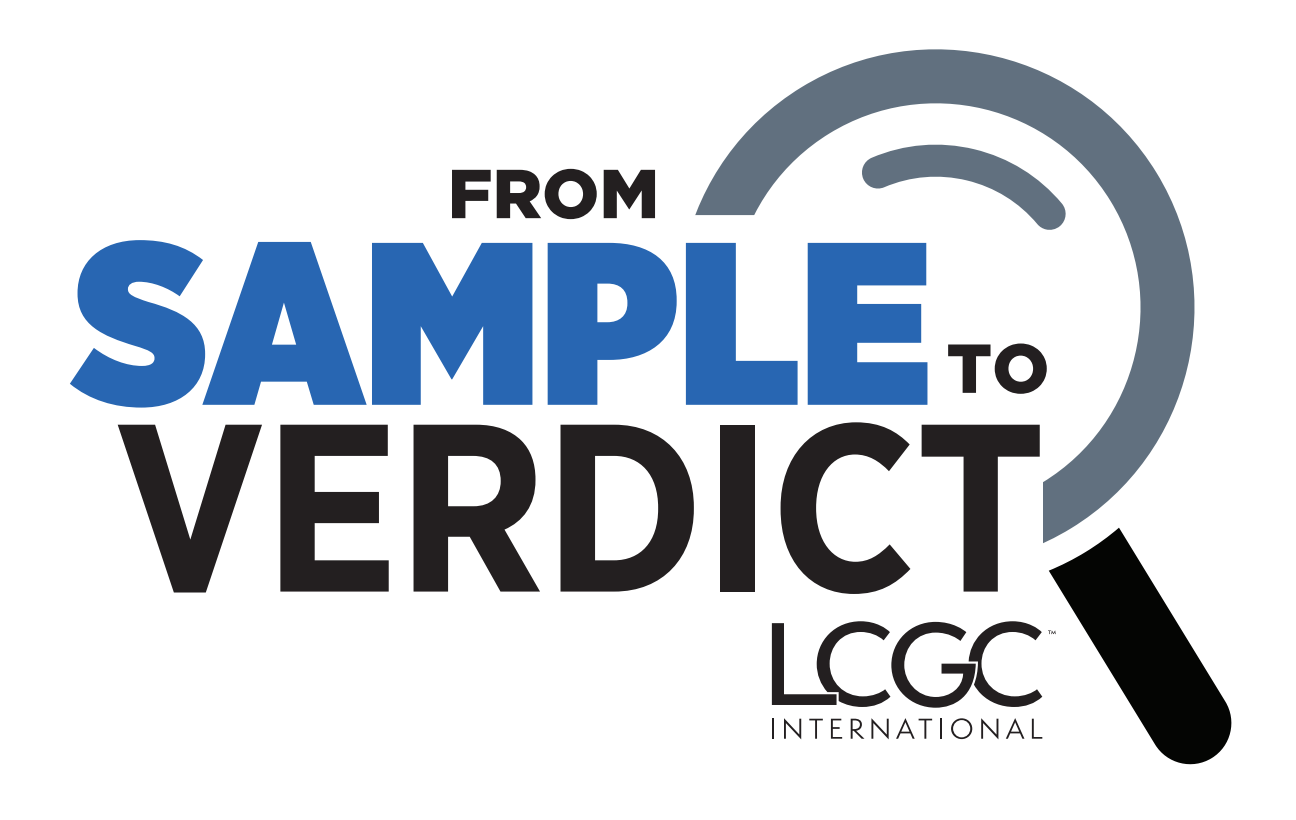Article
LCGC Europe
LCGC Europe
Russian Focus
Research Group: Dr Sc. Alexander Kurganov and Prof. Dr Sc. Victor Berezkin, Research Laboratory of Chromatography: Institute of Petrochemical Synthesis, Russian Academy of Sciences, Moscow.
Research Group: Dr Sc. Alexander Kurganov and Prof. Dr Sc. Victor Berezkin, Research Laboratory of Chromatography: Institute of Petrochemical Synthesis, Russian Academy of Sciences, Moscow.
Research Focus: The group performs research in gas chromatography (GC), liquid chromatography (LC) and thin-layer chromatography (TLC). The main focus is developing new techniques and methods for practical applications. Research in gas chromatography (GC) aims to extend monolithic capillary columns for high-speed and efficient separations and increase their performance under elevated pressures. The correlation of column separation properties with the monolith preparation parameters is one of the main areas of investigation. Other areas of interest include the theoretical aspects of high pressure gas chromatography (HPGC) and the active role of the carrier gas in GC. In LC, the main interest is on the preparation of monolithic capillary columns of optimized structures for analysing synthetic polymers, ions and chiral compounds. The fundamentals of polymer separation in the monolithic network of capillary columns are the most challenging area of these investigations. The TLC research has an emphasis on the acceleration of the flow of the mobile phase along the plates to increase the efficiency of separation and decrease the analysis time. The development of covered TLC plates and the use of the electroosmotic flow instead of conventional capillary flow is also being investigated.
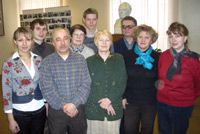
E-mail: kurganov@ips.ac.ru
Research Group: Dr Sc. Aleksey Buryak and Prof. Oleg Larionov, Laboratory of Physicochemical Principles of Chromatography and Gas Chromatography–Mass Spectrometry, The A.N. Frumkin-Institute of Physical Chemistry and Electrochemistry, Russian Academy of Sciences, Moscow.
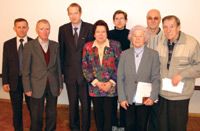
Research Focus: The laboratory focuses on two main areas: analytical applications of different types of chromatography and using chromatographic methods for physicochemical investigations. The technique developed in the laboratory for the identification of organic compounds, including isomers, in complex mixtures (Dr Sc. Buryak, Dr Alexsey Uleanov, Dr Svetlana Golub, Dr Tatyana Serdyuk, Sergey Paramonov, Elena Kuznetsov and Tatyana Rodina) is based on molecular-statistical calculations and chromato-mass spectrometry data. Components of complex mixtures of isomeric compounds in fuels, lubricants and environmental objects have been identified.
Investigation of surfaces is performed by gas chromatography–mass spectrometry (GC–MS), thermodesorption mass spectrometry (TDMS) and matrix-assisted laser desorption/ionization (MALDI) mass spectrometry (MS). The surface chemistry of construction materials for space technology after their contact with fuels has been investigated.
The surfaces of solids (adsorbents, catalysts and other support materials) are investigated using gas chromatography (GC), liquid chromatography (LC) and thin layer chromatography (TLC) and sets of appropriate test compounds. Currently, Prof. Oleg Larionov, Prof. Lubov Belyakova, Dr Luidmila Kolomiets, Dr Edward Jakubov, Anatoly Volkov, Svetlana Parkaeva, Aleksey Sukhozhenko and Ekaterina Uleanova are actively involved in the investigations of the surface properties of nanomaterials, nanoparticles (NPs) of metals and nanocomposites.
Combined chromatographic methods allow us to investigate NPs in both solid and micellar states to obtain information about their sizes and surface chemistry. GC is used to investigate the NPs of diamond and also the adsorption properties of silica of different structures, in particular modified by the NPs of silver and nickel.
Molecular weight distributions of natural and industrial of silicic acid solutions and chitosan samples are determined by high performance liquid chromatography (HPLC) by Dr Alexander Pronin and Dr Viktor Khabarov.
The antioxidant activity of biologically active substances and their complexes with metals, as well as their photolytic and radiation stability are also being investigated.
E-mail: kolom@phyche.ac.ru
Research Group: Prof. Sergey Lanin, Prof. Vladmir Davydov, Prof. Yuri Nikitin, Prof. Angel Serdan and Prof. Sergey Staroverov, Moscow State University.
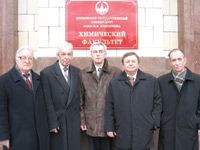
Research Focus: Prof. Lanin is involved in the synthesis and study of adsorption and catalytic properties of composites based on immobilized nanoparticles (NPs) of gold and bimetallic clusters (Au and Ni) on oxide supports. NPs of gold were shown to noticeably contribute to the total adsorption only when their average size does not exceed 10 nm. The sizes of the metal nanoclusters correlate with their catalytic activity in the processes of hydrogenation and isomerization of olefins and the hydrodechlorination of chloraromatic compounds.
Prof. Davydov works on the chemical modification of silica adsorbents for the chromatography of water-soluble fullerene derivatives for biomedical applications and also studies the adsorption and chromatographic properties of carbon nanotubes.
Prof. Nikitin investigates the retention and separation selectivity of various analytes in high performance liquid chromatography (HPLC) as a function of their structure, the properties of the adsorbent, the nature and composition of the mobile phase. The application of gas and liquid chromatography for the determination of physicochemical characteristics of adsorbents and catalysts.
Prof. Serdan deals with the preparation of heterosurface-type packings and their use in HPLC. Chemical modification provides the internal and external surfaces of the packings with differing properties. For a straightforward analysis of biological fluids several silica gel packings have been prepared with hydroxyl or amino groups on the external surface and unmodified internal surface.
The latter can also bear alkyl, cyano or amino groups. A direct determination of low-molecular weight compounds in synthetic polymers can also be performed on similar materials. Shielding of the outer surface by peptides or proteins was used to prepare packings containing octyl, cetyl, sulpho, amino, diethylaminoethyl or carboxyl groups on the internal surface.
Prof. Staroverov, director of joint stock company "BioChemMak", investigates the synthesis and physicochemical properties of chemically modified sorbents, including chiral stationary phases. This project deals with the solid-phase extraction (SPE) for ecological analysis and nutritional product characterization. Research is also performed in industrial- and preparative-scale chromatography of proteins, synthetic peptides and low-molecular weight compounds from natural sources.
E-mail: snlanin@phys.chem.msu.ru
Research Group: Prof. Ya.I. Yashin, Scientific and Technical Center "Chromatographia", NPO "Khimavtomatika", Moscow.
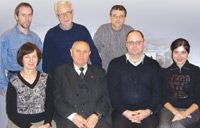
Research Focus: This research group develops high performance liquid chromatography (HPLC), gas chromatography (GC) and ion chromatography (IC) methods using various types of detectors, to determine some target admixtures in objects used in the environment, food, drinks and biological liquids.
Analytes of particular interest include phenols, chlorophenols, pesticides, anions in drinking, surface and wastewaters; biochemical markers (homocysteine, serotonin, catecholamines, modified nucleosides) to diagnose several diseases at their early stages; antioxidants (basically bioflavonoids, phenolic acids, vitamins) in food (vegetable oils, cereals, vegetables, fruits, berries, nuts, honey), beverages (juices, tea, coffee), drinks (wine, cognac, brandy, balsams, beer) and medicinal herbs. The antioxidant status of human on serum, plasma or saliva samples by applying a special construction involving amperometric detection is also performed.
E-mail: yashinchrom@mail.ru
Research Group: Prof. Ludmila Onuchak, Prof. Andzhela Bulanova, Prof. Svetlana Kurbatova, Department of the General Chemistry and Chromatography, Samara State University, Samara.
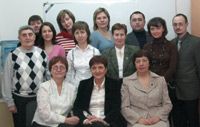
Research Focus: The group, involving Prof. Onuchak, Dr Igor Platonov and Dr Stanislav Kudryashov, develops new selective chiral gas chromatography (GC) sorbents based on chiral liquid crystals, modified cyclodextrins and nanoparticles (NPs). This involves theoretical and experimental studies to understand the physicochemical and hydrodynamic phenomena in columns; physicochemical and analytical applications of gas chromatography (GC); engineering projects on the miniaturization of GC techniques (porus layer open tubular (PLOT) and support coated open tubular (SCOT); short columns based on nanoparticles of aerosol, zeolite, porous graphitic carbon); and the development of heat conductivity microdetectors.
The chromatographic behaviour and separation, including preparative isolation of biologically active substances — adamantane and its derivatives, azoles, catechins — is also performed. Other projects include the study of "structure–property" relations and quantitative structure-retention relationships (QSRR) analysis. The development and evaluation of new sorbents based on modified nanoparticles of metals and ultra disperse diamonds is also being investigated.
Theoretical and experimental research into high-performance liquid chromatography (HPLC) and GC is a key research area for Prof. Bulanova, Prof. Kurbatova, Dr Elana Kolosova and Dr Klara Egorova. This work involves developing mathematical models of solute retention in HPLC; studying the influence of the carrier gas pressure and non-ideality of the mobile phase on the thermodynamics of sorption and separation of substances in GC.
E-mail: onuchak@ssu.samara.ru
Research Group: Prof. Vladimir F. Selemenev, Group of Chromatography, Department of Analytical Chemistry, Voronezh State University, Voronezh and Prof. Oleg B. Rudakov, Architectural-Building University, Department of Chemistry, Voronezh.

Research Focus: The group, headed by Prof. Selemenev, focuses on the development of analytical separation methods, recovery and determination of physiologically active substances (amino acids, peptides, vitamins, nucleotides, flavonoids, lipids) using ion exchange chromatography (IEC), liquid chromatography (LC), gas chromatography (GC) and high-performance thin-layer chromatography (HPTLC).
The group's activities include theoretical and experimental studies aimed at understanding the physicochemical phenomena underlying the separations; modelling and optimization of analytical and preparative procedures, particularly for physiologically active species; and developing new theoretical and experimental approaches to separation, extraction and analysis. This team is particularly interested in developing IEC and its reagentless applications. To realize these approaches, the group conducts fundamental studies on non-equilibrium chromatography; temperature effects in IEC and the development of modified sorbents using molecular imprinted polymers (MIPs).
The group has established numerous national and international collaborations. The team collaborates with the University of Oldenburg, Germany, and investigates possible applications of mesoporous composite materials modified by ionogenic groups in the field of separation of the previously mentioned classes of compounds.
The group led by Prof. Rudakov focuses on the analysis of natural organic and toxic substances using high performance liquid chromatography (HPLC) and GC. This research group is interested in the extraction and chromatographic properties of mixed solvents. It also develops expert systems for optimization of HPLC techniques using chemometrics.
E-mail: common@chem.vsu.ru
Research Group: Prof. Vadim Davankov, Laboratory of Stereochemistry of Sorption Processes of the Nesmeyanov-Institute of Organo-Element Compounds (INEOS), Russian Academy of Sciences, Moscow.
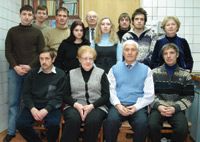
Research Focus: Laboratory LSSP was opened in 1975 with the aim of developing chromatographic techniques for separating enantiomers of amino acids and other important classes of organic compounds. This is a continuation of the work introduced by Vadim Davankov in 1968 on chiral ligand exchange chromatography as a general technique for resolving racemates of complex-forming compounds.
Currently, chiral chromatography using ligand exchange and other chiral liquid chromatography (LC) and gas chromatography (GC) techniques is investigated by Mikhail Ilyin and routinely applied for measuring the enantiomeric excess (ee) of numerous organic compounds obtained by asymmetric catalysis (Sergey Lyubimov). The group also plans to investigate prebiotic chirality resulting from self-assembling of organic compounds from inherently chiral primary particles.
Another field of active research is developing new polymeric adsorbing materials based on hypercrosslinked polystyrene, which was introduced by Prof. Vadim Davankov and Maria Tsyurupa in 1969. These "Macronet" materials are now available through Purolite Int., UK, for large-scale adsorption technologies in, for example, water treatment and sugar syrup decolorization. Recently, the group found a new application for nanoporous hypercrosslinked polystyrene in size exclusion chromatography (SEC) of mineral electrolytes, which allows preparative separations of mixtures of acids, bases and salts. The new process results in isolating the separated components in concentrations exceeding their concentration in the initial feed solution.
The hypercrosslinked polymers are also widely used in analytical chemistry for solid-phase extraction (SPE) of trace organic components from aqueous and gaseous media using Purosep (Pyrolite, UK) and LiChrolut EN (Merck, Germany) materials. Also, hypercrosslinked monodispersed microbeads are being developed as perspective column packing materials in HPLC by Mikhail Ilyin, Jr. Lyudmila Pavlova develops polymeric adsorbents for biomedical applications. New polymeric monolithic phases are also synthesized for capillary electrochromatography (CEC). Alexander Pastukhov examines the unusual physicomechanical properties of hypercrosslinked adsorbing materials.
E-mail: davank@ineos.ac.ru
Research Group: The research group of the Institute of Chromatography work on the design and production of microcolumn high performance liquid chromatography (HPLC) equipment and developing sampling procedures and chromatographic methods. The Institute has a private company called EcoNova Ltd, which works in close cooperation with the institutes of the Siberian branch of Russian Academy of Sciences and Novosibirsk State University.

Research Focus: Current research interests of the team, led by Dr Grigory Baram include developing high performance liquid chromatography ultraviolet (HPLC–UV) data banks for the quantitative analysis of various substances in simple and complex samples with automatic identification of peaks with the help of chromatographic and spectral parameters. The current HPLC–UV data bank for reversed-phase (RP) chromatography contains the parameters of more then 500 compounds, including drugs, narcotics, pesticides, food additives, and is used in forensic science and chemical laboratories, quality control laboratories in the food industry and for pharmacokinetics studies.
The team is also interested in predicting retention times and UV spectra of peptides with known primary structures in RP-HPLC. The special software for calculating the UV-multiwave chromatograms of peptides has been developed and is aimed at proteomic research applications. Another research project is the development of a computer training simulator to operate MiLiChrom A-02 HPLC instruments. This simulator emulates all the modes of HPLC instrument operation and aims to make operator training easier and less inexpensive. For more than ten years, EcoNova has organized weekly training programmes in HPLC four times a year.
E-mail: baram@econova.nsk.su
Newsletter
Join the global community of analytical scientists who trust LCGC for insights on the latest techniques, trends, and expert solutions in chromatography.

.png&w=3840&q=75)

.png&w=3840&q=75)



.png&w=3840&q=75)



.png&w=3840&q=75)
